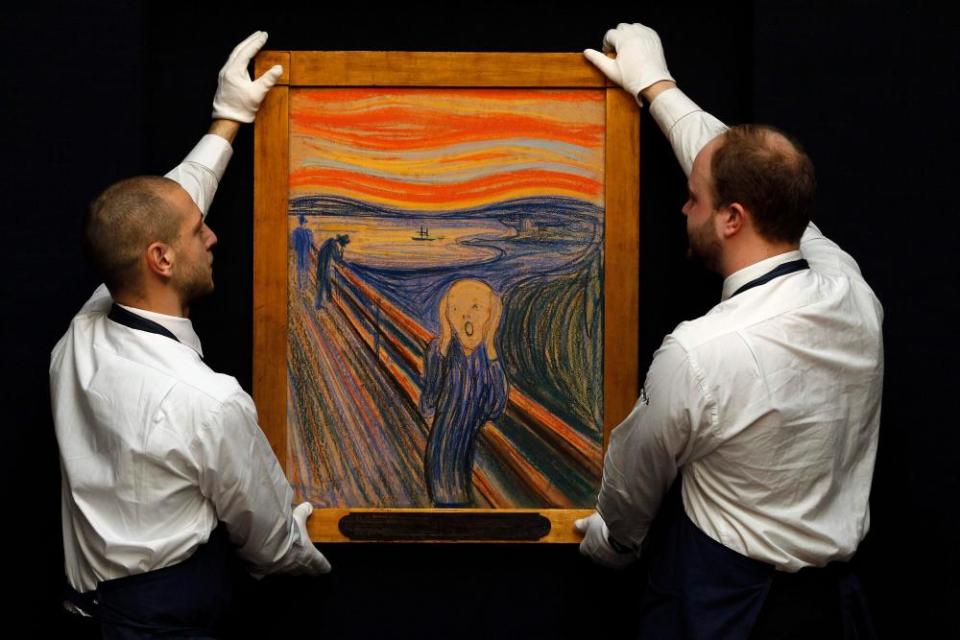The Scream: Munch London show 'not intentionally timed with Brexit'

There are days, as the Norwegian artist Edvard Munch well knew, when it is impossible to express one’s feelings in words, and only an image will do.
For those who may find themselves, for one reason or another, experiencing such a moment, the British Museum would like to help. Opening next month, it will host the largest exhibition of Munch’s prints in the UK in almost half a century, the centrepiece of which is a lithograph of the artist’s iconic work The Scream.
Having conceived the exhibition five years ago, the timing of its opening, according to its curator, Giulia Bartrum, is “pure serendipity – certainly at the moment when we are all worrying about bloody Brexit. But that’s actually sheer coincidence.”
Almost since it was created, says Bartrum, Munch’s image has been used to represent the human condition at different points in history. “It was used during the first world war, and at Greenham Common by the peace campaigners. It is used by the remainers outside parliament. You could plan this exhibition at any time and you would always key into some moment in society. When you look at images of The Scream in history, it comes up all the time.
“It just goes to show that this is an image of all time. We are always going to be anxious about something, and right now we are anxious about many things. Which is great in a way, but I feel it does take away from poor Munch and what he was trying to do as an artist.”
The Scream has been described as the second most recognisable image in art history, and is one of only a tiny handful of artworks to have its own emoji. But it was created in response to a specific incident experienced by the artist in early 1892 while walking on a road above Oslo with two friends.
“Suddenly the sky turned blood red,” he wrote, “… there was blood and tongues of fire above the blue-black fjord and the city – my friends walked on and I stood there trembling with anxiety – and I sensed an infinite scream passing through nature.”

The Scream at Sotheby’s in 2012. Most of the 80-plus prints in the exhibition have been loaned from the Munch Museum in Oslo.Photograph: Stefan Wermuth/Reuters
The earliest versions of the image were in colour, created the following year in tempera on cardboard. There are, in fact, four colour versions – two in the Munch Museum in Oslo, one in the city’s national gallery, and a fourth, which sold in 2012 for $120m (£90m), in private hands.
Most of the 80-plus prints in the exhibition have been loaned from the Munch Museum in Oslo, which will not lend the actual paintings, says Bartrum, after two high-profile thefts in 1994 and 2004 (the artworks were recovered each time). “They are very, very, very acutely anxious about them,” she says.
In any event, it was the black and white lithograph prints of the image, made from 1895, which made the image and the artist famous, she said. Even these are very rare, with about only 20 copies in existence, and with the Munch museum’s copies too fragile to travel, the exhibition has had to borrow the version on display from a private collector.
It was installed on Wednesday on a blood red wall, evoking the dramatic skies that had so seized the artist. “In the black and white print he condenses [the image], he hones in on this figure,” she says. “The bands of red, translated into black and white… it’s like a tuning fork, with the [waves] resonating around you.”
All the same, it is not her favourite work in the exhibition – and certainly those seeking images to capture a sense of existential agony will have plenty to choose from, with the exhibition also including prints of Munch’s works Despair and Angst, both reworkings of the same scene above Oslo.
Being so well known for a single image is more of a curse than a blessing, says Bartrum, “because it puts [Munch] out of context. Yes, it is great that he is instantly recognisable, but if you can just wear a little badge saying, ‘I feel like Screaming’ because you’re having a bad day, and it’s an emoji … that means people use it and don’t think about it at all.
“I have felt all along that I wanted to give Munch back his place in history and show The Scream as he originally envisaged it.”
• Edvard Munch: Love and Angst, supported by the AKO Foundation, opens on 11 April

 Yahoo News
Yahoo News 
